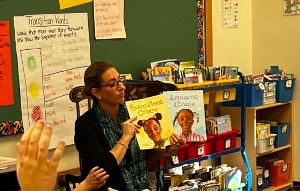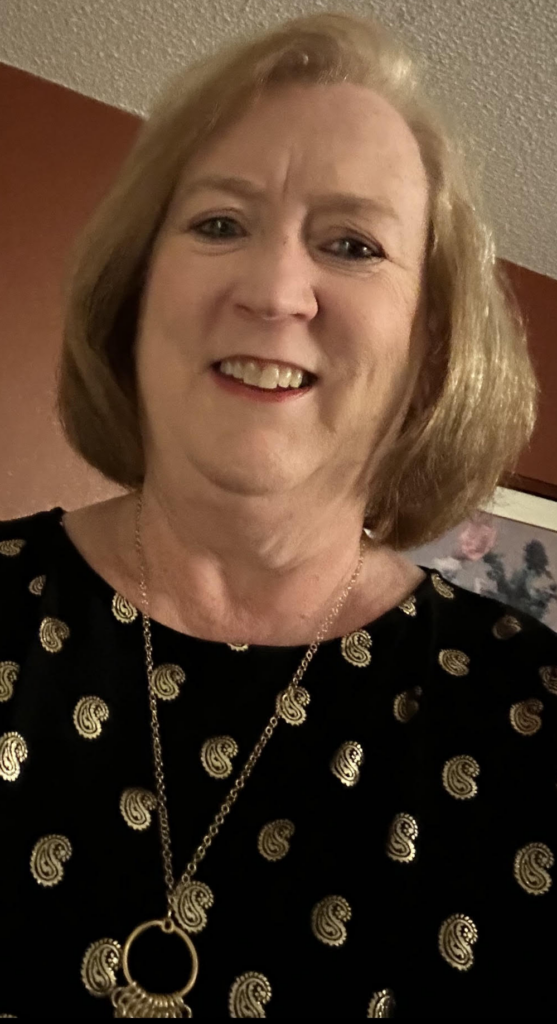
Principal Ellen Saxby and reading interventionist Lauren Szklany share how the comprehensive ELA curriculum, Collaborative Literacy, and the intervention program, SIPPS, are fueling literacy growth for students at Williamson Elementary School in Williamson, New York.
Interview with Ellen Saxby, Principal, Williamson Central School District, New York
Tell us a little about yourself, Williamson Central School District, and the students that you serve.
My name is Ellen Saxby. I am the building principal of the Williamson Elementary School, which serves grades UPK–4. I have been the principal for 11 years, but in the district for 35 years, including years teaching 1st, 3rd, and 4th grades.
Williamson Central School District is a small, rural district that is both progressive and innovative. We pride ourselves on being on the cutting edge of premier educational practices. Our teachers are encouraged to be creative problem solvers, while also focusing on collaboration.

The 2022–23 population of the elementary school was just over 400 students with four sections at each grade level, including one full-day classroom at UPK and four half-day classes.
In addition to an integrated class at each grade level we also had two self-contained special education classes in the building. We were able to provide Tier 2 academic intervention for students in both reading and math (reading in grades K–4, math in grades 2–4).
As a school and a district we are fortunate to be rich in technology and offer many opportunities for our students to have personalized learning.
What is the most rewarding part of being an educator for you?
Working with students and teachers is the most rewarding part of my job as an educator.
Each student and staff member comes from a different background, and so has different needs. My job is to work with students and teachers to help move them forward in their growth. I love dialoguing with teachers, staff, students, and families on how best to do that.
How long has Williamson been implementing Collaborative Literacy and SIPPS? Tell us a little about the implementation.
When I began at the elementary school as building principal we were in the height of the focus on the Common Core standards. District leadership implemented the NYS modules at the elementary level, so my job as building leader those first few years was to support that implementation. It was a challenging time for our building, and educators as a whole. I did not see the NYS modules as meeting the needs of our students, nor enhancing their literacy growth.
In the fall of 2017 my assistant principal and I began the process of searching for new ELA instructional materials. We spent the 2017–18 school year completing this process, with stakeholders involved along the way.
The assistant principal and I had been literacy teachers during our careers, so we had a vision of where we wanted to take our teachers and our students. We did our research and made plans each step of the way.
A neighboring school district, along with a person connected to the Greece Central School District, were experimenting with Collaborative Classroom curricula. Based on conversations with these neighbors, as well as our research, Collaborative Classroom ended up being one of our final three selections.
Through the selection process we narrowed our search to two programs that we presented to staff. At this stage of the process we conducted side-by-side evaluations, held presentations, and gave teachers opportunities to explore the materials.
In May 2018 we made a building decision to move forward with Collaborative Classroom, and I presented to our ASI and the Board of Education as the final steps. We planned to implement all three programs in the curriculum (Being a Reader, Making Meaning, and Being a Writer) beginning in September 2018.
What impact has Professional Learning in Collaborative Literacy and SIPPS had on your teachers and students?
Prior to implementing Collaborative Classroom materials, we visited a neighboring school (Newark Central School District) and talked to their staff about their rollout of the program. Although their implementation looked different from ours, it was helpful to work with that district.
The two main pieces of professional learning around our Collaborative Literacy implementation were the two-day learning session with a trainer from Collaborative Classroom and the in-house training we did throughout the first year.
We completed the two-day training conducted by Collaborative Classroom just prior to the beginning of the school year. It was wonderful and highly effective because we did it as a school community.
In addition, I devoted two instructional coaches to the implementation for the first year. We had monthly faculty meetings for this training, as well as opportunities for small groups and individuals to work with the coaches.
The professional learning from the onset has been a key factor in our success with the program.
The professional learning from the onset has been a key factor in our success with the program.
What thoughts or insights would you share with a school or district that is considering Collaborative Literacy and SIPPS?
I would highly recommend Collaborative Classroom programs for many reasons, and I would also recommend a process similar to ours. Teachers need to be involved from the very beginning and have a voice. They also need time to explore the materials and process them with their colleagues. The visitation to Newark helped us a great deal as well.
Teachers need to be involved from the very beginning and have a voice. They also need time to explore the materials and process them with their colleagues.
The professional learning we did during the implementation would be my strongest recommendation. It is a big curriculum with many components, so time and resources need to be allotted to becoming familiar with the materials and methodologies in order to make the implementation successful.
And we continually revisit where we are with student learning, which is also very important.
Interview with Lauren Szklany, Reading Interventionist, Williamson Central School District
Tell us a little about yourself, Williamson Central School District, and the students that you serve.
I am Lauren Szklany and I am a reading interventionist. This is my eighteenth year teaching and my third year on the Academic Intervention Services team. I have worked at Williamson for 8 years and have also taught 2nd and 3rd grades. I currently serve as our building Content Area Specialist in ELA.

What is the most rewarding part of being an educator for you?
The most rewarding aspect of being an educator is the ability to build relationships with students, their families, and my colleagues. Working in a small district has allowed me to collaborate with my peers in a way that benefits both our students and our staff as a whole.
I also live in the Williamson community, which gives me the unique perspective of both helping my students to learn and grow in the classroom as well as experiencing them applying that knowledge outside of our school setting.
How long has Williamson been implementing Collaborative Literacy and SIPPS? Tell us a little about the implementation.
Our staff began to implement Collaborative Literacy and SIPPS in the 2018–19 school year. This upcoming year will be our sixth year using the programs in our classrooms and as an intervention tool.
Our classroom teachers meet the diverse needs of our learners using Being a Reader, Making Meaning, and Being a Writer. We have also used SIPPS Beginning, Extension, Challenge, and Plus with groups of readers needing additional support in foundational reading skills.
Over the past few years we have worked hard to fully implement the programs while facing the challenges of teaching and learning during a pandemic. The Learning Portal was an excellent tool during our remote learning and has provided the consistency and resources our students and teachers have come to love about Collaborative Literacy.
The combination of research-based instruction, rich literature, and integrated social skills instruction greatly enhance our teaching practices!
The combination of research-based instruction, rich literature, and integrated social skills instruction greatly enhance our teaching practices!
What impact has Professional Learning in Collaborative Literacy and SIPPS had on your teachers and students?
The professional learning we received when implementing Collaborative Literacy truly impacted our ability to learn, grow, and reflect on our practices as educators. Our building administration knew from the start of implementation that supporting teachers through our first year with the programs would be essential.
Our comfort grew as we worked together on grade-level teams to dive deeper into the resources included in our manuals and on the Collaborative Classroom Hub (now the Learning Portal). Devoting the time necessary to understanding the facilitation techniques and cooperative structures embedded within the programs has made our learning community stronger.
Watching master teachers in action has allowed us to implement the program the way it was intended. Access to the SIPPS implementation guidance, videos, and resources within the Portal really supported our learning and growth as an intervention team.
Our intervention team found the videos embedded in the SIPPS manual and available on the Learning Portal an invaluable resource as we put the program into practice. Watching master teachers in action has allowed us to implement the program the way it was intended.
Access to the SIPPS implementation guidance, videos, and resources within the Portal really supported our learning and growth as an intervention team.
What thoughts or insights would you share with a school or district that is considering Collaborative Literacy and SIPPS?
I have had the opportunity to experience Collaborative Literacy and SIPPS through two different lenses.
As a classroom teacher, I would advise giving yourself the gift of patience and time when first implementing the program. Take advantage of the resources available to you both in print and digitally. Devote time to working as a team both within your grade level and with the full staff to share successes and problem solve together.
As an interventionist, I appreciate the data that teachers have at their fingertips and the ability to make intentional decisions about how to differentiate learning. Collaboration between teachers and support staff is essential and easily facilitated with the data that SIPPS provides.
***
Hear From Other New York Literacy Leaders
The Impact of Collaborative Literacy and SIPPS in Brockport Central School District
Big Results in the Big Apple: Middle School ENL Teacher Desiree Torres on SIPPS
Newark Central School District’s Improvement Journey with Collaborative Literacy and SIPPS
